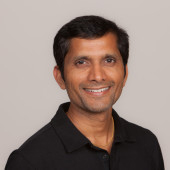Follow The Molecule: One Man's Tale Of Commercialization And Outsourcing

By Louis Garguilo, Chief Editor, Outsourced Pharma

This is a story of drug and personal development. It demonstrates why our industry deserves respect for its accomplishments, and recognition of the individuals who drive them.
Over two editorials, I’ll lay before you a parallel narrative of humble beginnings and grand endings.
For the drug: We’ll trace a path from a research program cycled through biotechs, to eventual commercialization at Celgene (now Bristol-Myers Squibb). Ozanimod for the treatment of relapsing forms of multiple sclerosis (RMS) is expected to gain FDA approval in March.
For the man: We’ll travel from a rural village in India without a school past 5th grade, to a center of biotechnology in the U.S., and a key role in advancing that drug.
“I’m happy to share my story,” Brahmachary Enugurthi, Manager, API Development and Manufacturing, Bristol-Myers Squibb, says quietly from his San Diego office. “But I’m not saying this way of ‘following the molecule’ works for every individual or company. I am a humble person.”
But not too humble to in the process of telling his story, also add a productive outsourcing strategy.
A Molecule – And Scientist – Advance

Apoptos was founded by former Biogen researchers, who after starting on an original oncology program, quickly realize it’s not right for the target indication of focus. They start looking for a replacement.
About the same time, researchers from The Scripps Research Institute form a company named Receptor Pharmaceuticals. The company is focused on an S1P receptor program – and looking for funding. (S1P1 receptor modulators play a key role in the treatment of autoimmune diseases.)
In 2009, Receptor and Apotos combine to form Receptos, Inc. and continued the S1P1 program, targeting autoimmune diseases such as multiple sclerosis (MS), ulcerative colitis (UC) and Crohn’s disease. The Receptos team optimizes and selects RPC-1063 as its clinical candidate.
“I happened to be a lucky chemist,” says Enugurthi. “RPC-1063 ends up becoming Ozanimod, now close to approved by the FDA, and also closing in on approval in Europe.”
The “lucky” medicinal chemist worked on the program from discovery through first-in-human clinical trials, helped lead CRO strategic outsourcing partnerships, and supported various aspects of the drug development activities.
“We were a virtual operation and so also relied on external services and networks,” explains Enugurthi. “But when our research team moved on to other programs, I continued to spend a good part of my time supporting RPC-1063 development activities.”
“I was a lab scientist, but management encouraged all employees to keep patients in mind, why we do what we do, and to always think like patient advocates. That culture encouraged me to make some strong connections with the MS society.
“I heard several talks from patients about their disease and how grateful they were for what we were doing. That inspired me. I thought: ‘I can do more to help these patients.’ I was just waiting for the right timing to advance with the program.”
That right time came when Celgene acquired Receptos, in 2015.
“I took the initiation to talk to both my research head and the development lead about moving into CMC,” Enugurthi recalls. “They were both supportive, and the transition was smooth, although I had a lot to learn. I was able to bring ‘legacy knowledge’ to the development team to address any anticipated or unexpected challenges. That's how I moved from research into CMC.”
Although Enugurthi’s experience of a bench scientist advancing to CMC is not unique, it is certainly not the norm – nor precisely is the concept of ‘following the molecule.’
Does Enugurthi think this should be done more routinely?
“I don't believe a single policy, or strategy, would work for every company,” he replies. “This is individual and situational, depending on where people are in their career state, and the program itself. Some scientists are born to discover new things and happy staying in research.
“Instead, management should just be flexible. They will benefit from understanding better who their employees are, and their aspirations. In my case, I had managers who were supportive of my transition. And it was good for the molecule’s advancement.”
At The CDMO
How did Enugurthi’s move help the CMC group with its outsourcing activities?
“For one,” he replies, “After some twelve years, I still work with some of the same vendors I started with. We have great relationships. I don’t think of service providers as simply providers of services.”
He explains: “I try to be transparent and respectful with them. As much as possible, I have always made our CROs a part of the projects we’re working together on. Some have supported us throughout the entire CMC process. I knew which vendors were technically matched to our needs, their capabilities and strengths … and their flexibility. I developed this strategy through my experiences at my current and past jobs, including my first at a a CRO,” Enugurthi adds.
“In my current role, I’ve had to make special requests of CROs to provide additional documentation, and raw data for the traceability we subsequently needed. Some CROs are not equipped that way.”
The Celgene CMC team had already selected their CDMOs for API manufacturing when Enugurthi arrived. Registration and validation batches were underway. Yet he’s certain he was helpful to those CDMOs, and assisted in advancing the project and building relationships.
Enugurthi began providing the CDMOs valuable insight and background on the molecule; knowledge that, unfortunately, too often is not transmitted from early researchers to the development and manufacturing scientists and engineers.
“In most outsourced development and manufacturing programs, the internal CMC teams need to provide ongoing supplemental support to their CDMOs,” he explains.
“For example, we have labs on site to do additional experiments. These provided valuable data that in many cases helped resolve chemistry or process problems. We helped solve chemistry issues and expedited critical timelines and investigations.
“I visited the API manufacturing plants, and had regular communication with our partner CDMOs. I believe they appreciate having a subject matter expert with historic knowledge on the team.”
Rinse And Repeat?
Now that Ozanimod is about to become a commercial drug, will Enugurthi repeat the cycle and head back to med chem to potentially follow another project?
“That’s a good question,” he replies with a soft laugh.
“I’d like to continue what I'm doing now. Having that research background helps to contribute positively to development programs. I don't think I have to start from the beginning again. There are lots of activities related to other research projects coming through the transitions, where my broader experience is valuable. But it’s an interesting thought,” he concludes.
--------------------
In our second part with Brahmachary (Chary) Enugurthi of Bristol-Myers Squibb, we’ll go back to trace his personal odyssey from rural India to biotech-center San Diego.
I met Enugurthi at Outsourced Pharma San Diego in October 2019. Readers interested in attending can learn about our upcoming conferences here. Or feel free to email me with questions.
